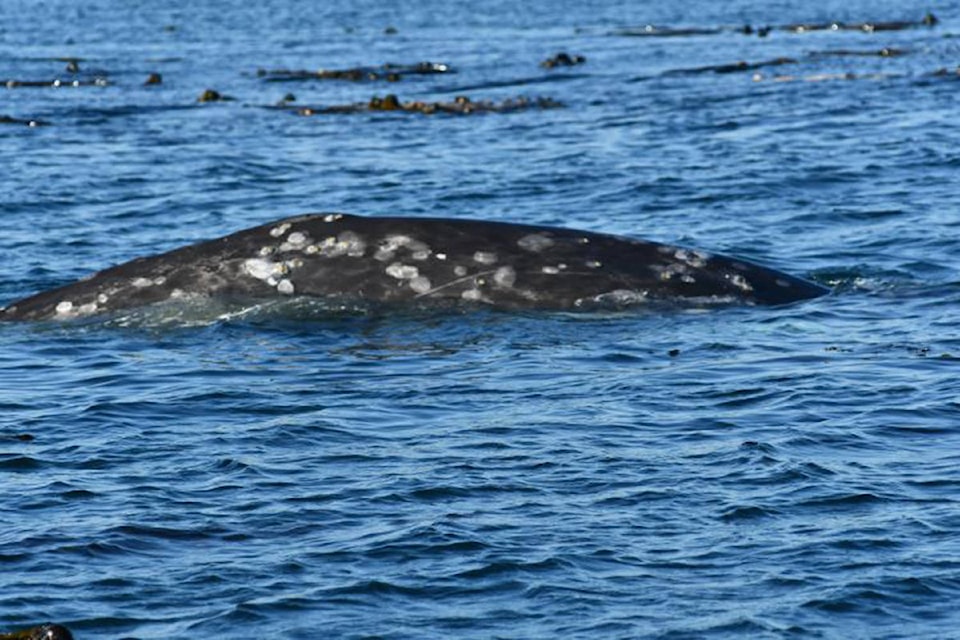A grey whale off the coast of Vancouver Island is being monitored by Canadian and U.S. researchers, as it has developed lesions after being tagged last year.
Three grey whales from the Pacific Coast feeding group were satellite tagged off the coast of Washington in September 2020 by the U.S. National Oceanic and Atmospheric Administration – NOAA Fisheries. The tagging is part of a research project on the group of whales, conducted in collaboration between NOAA Fisheries, Fisheries and Oceans Canada and the Vancouver Aquarium.
The tags are aimed to gather information about whales’ behaviour, breeding areas, habitat, feeding and migratory patterns.
“We photographed this particular whale on Sept. 4 prior to tagging. At the time, we determined that the whale was in good condition and was a good candidate for tagging,” said Sharon Melin program manager for the California Current Ecosystem Program at NOAA Fisheries. “We only undertake tagging when we are confident the risk to the animal is low.”
READ ALSO: Rare bird spotted at Vancouver Island backyard feeder
The groups have been monitoring the whale over several months and collected images of it on Sept. 25, Oct. 4 and Dec. 9, 2020, with no abnormalities. However, on March 16, the whale was reported to have a wound around the tagging site, as well as two more lesions on the opposite side of its body.
A panel of U.S. and Canadian whale experts was formed following the veterinarian’s report, who gathered more information on the whale’s condition, and developed a response plan.
Dr. Martin Haulena, a veterinarian with the Vancouver Aquarium and Marine Mammal Rescue, said the wound near the tagging site appeared to have a radius of about 20 to 30 cm, and the corresponding patches were about the same size. It is still unknown why the lesions on the opposite side of the whale’s body occurred, and whether or not they are related to the tagging site.
To try and prevent anything more serious – such as systemic infection – from developing, the team administered antibiotics to the whale on March 31 and April 1. Antibiotics were administered using a CO2 rifle, which shot darts carrying the medicine into the whale’s body.
Along with the antibiotics, the team also collected a breath sample to further evaluate the whale’s well-being, and sample for any bacterial, viral and fungal pathogens of concern.
“The observed animal was also coughing up a little bit of mucus while moving, suggesting irritation in the airway. Antibiotics will help against any respiratory infection as well,” said Haulena.
The panel will continue to monitor the whale but has agreed the lesions did not pose an imminent danger to the animal’s health.
READ ALSO: Sea lion randomly spotted on remote B.C. logging road
It can take anywhere from four months to a year for a tag to migrate out of a whale’s body. The tags act in a similar way as a splinter would in a human, and are designed to eventually work their way out of the whale’s body as the site continues to heal. Tags are implemented into the dorsal midline of the whale.
“We are hopeful that once this satellite tag is extruded, the tissue around the tagging site will heal. But we will continue to monitor the whale’s condition closely,” states the NOAA website. The satellite tag on this whale is said to be the last one remaining.
This tagging study was conducted to learn about the approximately 250 grey whales who make up the Pacific Coast feeding group. The group is part of the eastern north pacific grey population, which totals about 20,000.
“This group is so unique that they don’t migrate like the larger population does. Most travel to Alaska during the summer for breeding, but this group stops off our coast and spends the summer feeding here,” said Melin.
“We don’t know whether they stay all year round, and satellites help us find more information about how they are using the habitats and where they move. We consider them unique and we want to learn more about them.”
Do you have a story tip? Email: vnc.editorial@blackpress.ca.
Follow us on Twitter and Instagram, and like us on Facebook.
